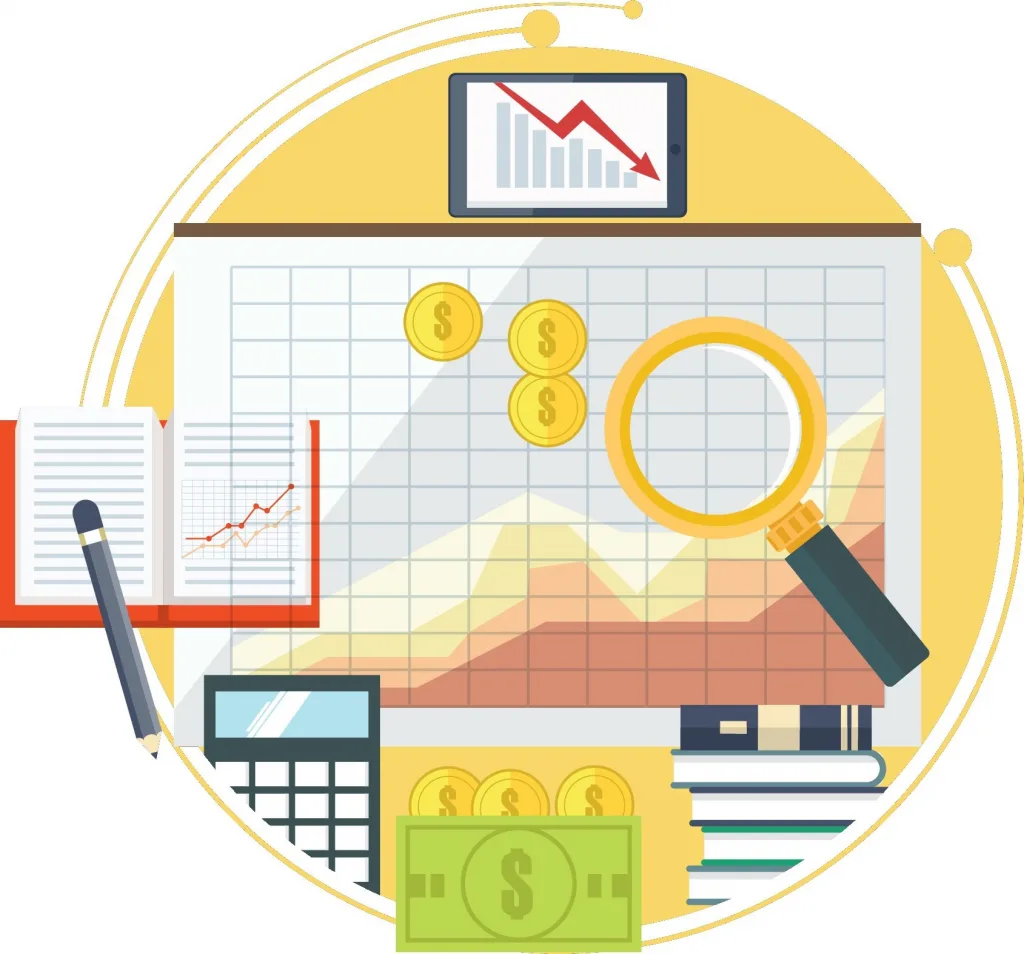Understanding the Basics: What is Data Analysis and Analytics and Why is it Crucial in Today’s Business?
Data analysis is the process of inspecting, cleansing, transforming, and modelling data to uncover meaningful information, conclusions, and support decision-making. Data analysis plays a crucial role in enabling organisations to make informed decisions based on facts rather than intuition.
Disclosure: If you click on my affiliate/advertiser’s links, I am going to receive a tiny commission. AND… Most of the time, you will receive an offer of some kind. It’ s a Win/Win!
Businesses rely on data analytics to drive strategic planning and operational improvements through data-driven decision-making. By analysing patterns and trends within datasets, companies can identify opportunities for growth, optimise processes, and mitigate risks effectively.

© captainvector, 123RF Free Images
Proficiency in data analysis skills is becoming increasingly valuable in the job market as businesses seek professionals who can interpret complex datasets and translate them into actionable insights. It is one of the many useful skills to have as part of your business acumen.
The benefits of data analytics are manifold – from enhancing operational efficiency to improving customer experiences and predicting future trends. Ultimately, leveraging the power of data analysis empowers businesses to stay competitive in today’s dynamic market environment.
Data Analysis vs. Data Analytics: The Key Differences
Data analysis and data analytics are often used interchangeably, but they have distinct differences. Data analysis focuses on examining data to draw conclusions, while data analytics involves a more comprehensive approach that includes interpreting, modelling, and deriving insights from data.
One key difference is that data analysis is more about examining past data to understand what happened, whereas data analytics goes beyond this to predict future trends and outcomes. Data analytics is seen as more beneficial as it provides actionable insights for decision-making based on predictive models.
That’s correct! Data analysis involves examining historical data to gain insights, while data analytics takes it a step further by using that information to predict future trends and outcomes. By leveraging predictive models, data analytics can provide valuable insights for informed decision-making. It’s a powerful tool for businesses looking to stay ahead in today’s competitive landscape.
In summary, while both are valuable in their own right, data analytics is considered better as it encompasses the outputs of data analysis and adds predictive capabilities for informed decision-making.
The Role of Data Analysis in Decision Making: How Businesses Benefit from Analysing Data
Data analysis plays a crucial role in decision-making for businesses, enabling them to make informed and strategic choices based on evidence rather than intuition. By utilising business analytics, companies can harness the power of data-driven decisions to drive growth and success.
Predictive analytics and data science tools allow businesses to forecast trends, identify patterns, and anticipate future outcomes with greater accuracy. This empowers organisations to proactively address challenges and seize opportunities before they arise.
Through effective data interpretation and modelling, businesses can extract valuable insights from complex datasets, enabling them to gain a competitive edge in the market. Business intelligence derived from data analysis helps companies streamline operations, enhance customer experiences, and optimise performance across various functions.
Free accounting software for small businesses. Click HERE
Exploring Different Types of Data Analysis Techniques for Varied Business Needs
Data analysis techniques play a crucial role in helping businesses make informed decisions. Let’s explore different types of data analysis techniques that cater to varied business needs:
1. Descriptive analytics: This technique focuses on summarizing historical data to understand what has happened in the past. It provides valuable insights into trends and patterns. By analysing trends and patterns, this approach can provide valuable information about what has occurred previously.
2. Diagnostic analytics: By delving deeper into data, diagnostic analytics helps businesses understand why certain events occurred. It identifies the root causes behind specific outcomes. Diagnostic analytics is a crucial tool that allows businesses to uncover the reasons behind certain events by delving deeper into data. By identifying root causes, businesses can gain valuable insights into specific outcomes and make informed decisions based on this understanding.
3. Predictive analytics: This technique uses historical data to forecast future trends and outcomes. Businesses can leverage predictive analytics to anticipate customer behaviour or market trends. By analysing past data, businesses can gain valuable insights into customer behaviour and market trends, allowing them to make informed decisions and stay ahead of the competition. Leveraging predictive analytics can help businesses anticipate changes in the market landscape and adapt their strategies accordingly.
4. Prescriptive analytics: Prescriptive analytics is a powerful tool that goes beyond prediction by not only forecasting future outcomes but also recommending specific actions that businesses should take. By leveraging insights derived from thorough data analysis, prescriptive analytics helps companies make informed decisions to drive better outcomes and achieve their strategic goals. It enables organisations to proactively shape their future rather than simply reacting to it based on past trends.
5. Qualitative analysis: Qualitative analysis involves interpreting non-numerical data such as text or images to gain a deeper understanding of customer sentiments or preferences. By examining the nuances of language and visual cues, researchers can develop a deeper understanding of individuals’ thoughts and feelings towards a product or service. This type of analysis is valuable for uncovering rich, detailed insights that may not be captured through quantitative methods alone.
6. Exploratory data analysis: Exploratory data analysis is a crucial technique in the field of data science and statistics. This technique involves exploring data sets to uncover patterns, anomalies, or relationships that may not be immediately apparent, guiding further investigation. This process helps guide further investigation and aids in making informed decisions based on the data at hand. By carefully analysing and interpreting the data, researchers can gain valuable insights that can inform future actions or strategies.
7. Quantitative analysis: Quantitative analysis involves the use of numerical data and statistical methods to draw conclusions and make decisions based on empirical evidence. It is commonly used in various fields such as finance, economics, science, and research to examine patterns, trends, and relationships within data sets.
By employing a combination of these diverse data analysis techniques, businesses can extract valuable insights from their data and drive strategic decision-making across various functions and industries.
The Tools of the Trade: Exploring the Top Data Analysis Software and Platforms
Data analysis tools and software play a crucial role in extracting insights from data. By exploring the top data analysis software and platforms, businesses can make informed decisions based on accurate information.
When it comes to data analysis, having the right tools is essential. From data visualization tools to analytics platforms, there are numerous options available for professionals in the field of data analytics. Data visualization tools enhance the understanding of data by presenting information in a visually compelling manner.
Indeed, professionals in the field of data analytics have a wide array of tools at their disposal, ranging from data visualization tools like Tableau and Power BI to analytics platforms such as Google Analytics and IBM Watson. These tools play a crucial role in helping professionals analyse and interpret data effectively to derive valuable insights for decision-making purposes. It is essential for professionals to stay informed about the latest advancements in these technologies to ensure that they are using the most efficient tools for their analytical needs.
By understanding the best tools for data analysis and utilizing them effectively, businesses can streamline their processes, identify trends, and gain a competitive edge in today’s data-driven world.
From Raw Data to Actionable Insights: The Process of Effective Data Analysis
Effective data analysis involves a systematic process of transforming raw data into actionable insights. This process typically includes data interpretation, utilising data mining techniques, employing statistical analysis methods, and leveraging predictive analytics.
Data analytics techniques play a crucial role in extracting valuable information from large datasets. By applying data mining methods and statistical analysis in data analytics, organisations can uncover patterns, trends, and correlations that can inform strategic decision-making. This valuable insight can then be used to make informed strategic decisions that can benefit the organisation’s objectives.
Advanced analytics further enhances the data analysis process by using sophisticated algorithms to predict future outcomes and identify opportunities for improvement. By understanding the intricacies of these analytical processes, businesses can gain a competitive edge and drive innovation based on evidence-based insights derived from their data.

The Impact of Big Data on Modern Data Analysis Practices and Challenges Faced
Big data has revolutionised modern data analysis practices by providing vast amounts of information for businesses to analyse and derive insights from. However, along with its benefits, big data also presents challenges in terms of processing and analysing such large volumes of information.
The use of big data tools and technologies has enabled organisations to make more informed decisions based on data-driven insights. These tools help in processing, storing, and analysing massive datasets efficiently. The integration of big data tools and technologies has significantly enhanced the decision-making process for organisations by providing valuable data-driven insights.
These tools play a crucial role in efficiently processing, storing, and analysing vast datasets to extract meaningful information that can drive informed decisions and strategies. The ability to handle large volumes of data effectively has revolutionised how businesses operate and make critical decisions in today’s data-driven world.
Despite the advantages, challenges in data analysis arise due to the complexity and volume of big data. Issues such as ensuring data quality, maintaining data security, and extracting meaningful insights from the vast amount of information available are some common challenges faced by organisations working with big data.

The Role of Data Analysts in Driving Business Success: Skills and Responsibilities
Data analysts play a crucial role in driving business success through their analytical skills and expertise. To excel in this field, data analysts need a combination of technical skills, problem-solving abilities, and strong attention to detail.
The responsibilities of a data analyst typically include collecting, processing, and analysing large sets of data to identify trends and insights that can inform business decisions. They also need to have excellent communication skills to effectively present their findings to key stakeholders.

Image by rawpixel.com on Freepik
In terms of career opportunities, the demand for skilled data analysts is on the rise across various industries such as finance, healthcare, marketing, and more. Those interested in pursuing a career in data analytics should focus on developing skills in statistical analysis, programming languages like Python or R, data visualization tools like Tableau or Power BI, and critical thinking.
By honing these analytical skills and staying updated with the latest trends in data analysis techniques, individuals can pave the way for a successful career as a data analyst.
Data Analytics Trends to Watch Out For in 2025 and Beyond
In the ever-evolving world of data analytics, staying ahead of trends is crucial for professionals in the field. By keeping an eye on emerging trends, such as predictive analytics innovations and the integration of AI and machine learning in data analysis, individuals can adapt their skills and strategies to meet the demands of the future.
As we look towards 2025 and beyond, big data trends are expected to continue shaping the way organisations harness information for decision-making. The convergence of advanced technologies like AI in analytics promises to revolutionise how data is processed, interpreted, and utilised for actionable insights.
By understanding these key trends in data analytics, professionals can position themselves at the forefront of innovation and drive value for their organisations through informed decision-making processes.

Conclusion: Harnessing the Power of Data Analysis to Drive Success and Innovation in Every Sector
In conclusion, harnessing the power of data analysis is crucial for driving success and innovation across all sectors. By empowering your business with data-driven decision-making, you can gain valuable insights that can lead to strategic advantages and improved performance. Harnessing the power of data analysis is indeed crucial for driving success and innovation across all sectors.
Data analysis helps in identifying trends, patterns, and correlations that might not be immediately apparent, allowing businesses to make informed decisions based on evidence rather than intuition. It enables organisations to optimise processes, understand customer behaviour better, identify new opportunities for growth, and ultimately stay ahead of the competition in today’s data-driven world.
Implementing best practices for analytics strategies is key to leveraging data analysis effectively. By investing in the right tools and technologies, businesses can unlock the full potential of their data and make informed decisions that drive growth.
Leveraging data analysis and analytics not only helps in making better decisions but also enables businesses to stay ahead of the competition. By embracing a data-driven approach, organisations can adapt to changing market dynamics, identify new opportunities, and drive success in every sector.
- Turn AI Anxiety into Competitive Advantage: How to Future-Proof Your Workforce for the AI Revolution
- Unlock Profit: Calculate Customer Lifetime Value & Maximize Growth
- Creating a Customer Persona: A Step-by-Step Guide On How To Do It
- Unleashing the Power of Digital Signage: The Best Software to Transform Your Business
- How Businesses Can Use Freelance Platforms & Expert Networks to Scale Smarter








